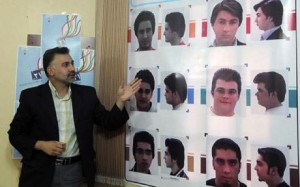Let’s Talk About Muslim Men and Hair

In 2010, the Cultural Ministry of Iran issued a catalogue of haircuts that the government approved. The list of banned styles includes ponytails, mullets and elaborate spikes. Courtesy: Telegraph, Photo credit: Reuters
When hair comes up in the context of Muslims, it is women who first come to mind. So I’m taking an unexpected look this week at the subject of men and hair.
There is a huge emphasis in Muslim cultures on washing and cleanliness, which stems from the religious edicts to wash before every prayer. Apart from the obligatory washing, there is also a high recommendation to bath on Fridays before attending Friday prayers.
Religiously and culturally men want to look clean and well presented – a kind of Muslim equivalent of ‘Sunday best’. There is no turning up to Friday prayers looking unkempt. Hair is a critical part of this. One additional component of Friday attire is being well perfumed, traditionally using oil-based perfumes. In some Muslim cultures men will oil their hair with natural oils after showering. Why not combine the two?
In immigrant Muslim populations from the Subcontinent to the West, for young men to keep long hair was often considered culturally as a sign of decadence and defiance, a sense that the young man had rejected his culture and was becoming westernised and rebellious. However, some young men countered that the long hair was in fact *more* Islamic, because it was in the tradition of the Prophet who himself had kept long hair.
That there might be Islamic traditions or directives about how men’s hair should be style was nowhere more evident that this style advice issued by the Iranian government on acceptable hair styles for men.
Unlike the subcontinent’s view that men’s hair should tend towards the shorter, middle eastern men, particularly from desert and rural areas tend to sport (or tended to at least) longer hair. In desert areas, such as with the Berber or in Egypt and Saudi Arabia for example, men would almost always cover their hair out of necessity. These days it is still common as part of ceremonial head dress. Berbers will use traditional scarves – for example the beautiful blue of the Touareg – whereas in the Gulf the keffiyah is worn by Arabs only. In Oman they have the more colourful and stylish turbans.
It is ‘sunnah’ – recommended – for men to cover their hair when they pray or go to the mosque, and to this end they may wear a small cap when praying. Younger men may be conscious that such caps could ruin their hairstyles, or sit awkwardly on styles with heavy product. Alternatively they may decide to forego the sunnah and not wear a cap at all, after all, covering their heads for prayer is recommended not mandatory.
Dyeing hair using henna is also customary, but this tends to be decreasing in popularity amongst younger men. Henna is very unpredictable in its colour, and often tends to leave an orange hue in the hair which older men favour but younger men dislike. If only henna could be included for its religious piety but shampoo or colour could be controlled…
The most obvious point when it comes to Muslim men and their hair is in fact their facial hair. After all, this is the most significant difference between Muslim men (and some other men of faith) and their non-Muslim counterparts. A lot of Muslim men have beards and goatees. This is something that occupies their grooming routine more than anything else. They may want to combine their faith with style. Beards are not usually popular in western countries, so goatees have become popular among younger men, sometimes frowned upon by older men who do not see this as a ‘proper’ beard.
Hair hygiene and grooming is important for Muslim men, just as it is for Muslim women. The fact that the debate about Muslim women’s hair features more prominently in modern day discussions about Muslims shouldn’t make us forget that men and their hair also need our attention.
This is part of the Insider’s View blog series by the author. Courtesy : Ogilvynoor























Connect
Connect with us on the following social media platforms.